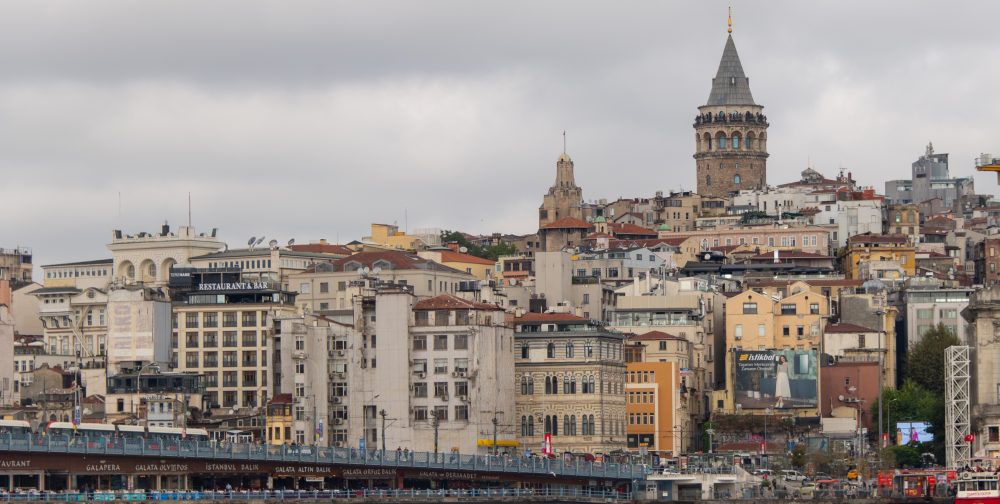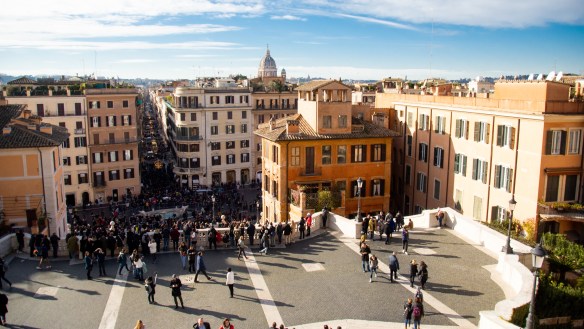Read from the beginning: [Rome, Part I] [Rome, Part II] [Rome, Part III]
Day 5: So we set out early today, and walk the familiar streets across the Forum, over the river and through the…Not Throngs! We arrive at the Vatican before 9am and are greeted by an early morning glow in St. Peter’s Square. It’s so much more peaceful here without the hordes, where you can actually see the square. But it’s a strategic decision, because one cannot get to the Vatican Museum (and Sistine Chapel) directly from the Basilica, so it was a choice to either start here or there and then stand in line for the other.

The cathedral is spectacular: it’s an opulent display of the Church’s wealth and stature, and the artwork is stunning even to this heathen’s eyes (involuntarily hoping I won’t burst into flames in the center of the room; that would be both messy and embarrassing, and my companion would not be amused. Or maybe he would 😉).


The Pietà 

There’s an admission fee to get in to see the Basilica’s Duomo, which feels inherently wrong to me. A devotee to what is essentially the best-funded religious organisation on the planet makes a pilgrimage to the Holy See and still has to pay to see all of it. Fact: you can pay 2€ less if you “walk” (it’s 500 steep, narrow, windy marble steps; you save 100 steps per € or so if you ride the elevator part-way up). Another fact: it was designed by Michelangelo, who had a hand in a lot of the artwork here, the Pietà and the walls and ceiling of the Sistine Chapel for starters.
I’m a visitor, and not remotely Catholic, so I don’t exactly mind the fee, but there are a thousand other churches in Rome, some equally beautiful, that one can just wander into without a queue or the purchase of an E ticket. That said, the view from the top is stunning: you can see the entire city on this crisp, clear morning.
Next stop: the Vatican Museum. It’s barely 10:30 when we arrive, and the line is already around the corner. So the choice becomes whether to wait the 2+ hours in the queue or pay one of the hustlers on the street for a “skip the line” pass and walk in. We cave to temptation and are shuffled, first to the ticket office, then to the front of the line (to get to the other line to enter the museum). It all seems like a grand scheme to extort € from tourists, but this being our last full day, we don’t want to spend it waiting. Until we get inside and realise we’re packed into the halls, surrounded by tour groups from a multitude of lands, each guide sporting a pom-pom on a stick and shepherding their lot through the galleries. Oh, the imagery.

The sea of visitors 



It is, as they say, what it is: we flow with the crowd through the different halls (Raphael’s Philosophy mural, School of Athens, blows my mind: Aristotle and Plato and a cameo by Raphael himself in vibrant hues – incredibly preserved since the 14th Century!), from here through the tapestry-lined hallways and to the Sistine Chapel. As we wander, it strikes me as ironic that the Church has plastered and painted fig leaves on many of the works.
I had expected a chapel, not a grand ballroom filled wall-to-wall with bodies, necks craned to take in the masterpieces that surround. It’s here I learn that Michelangelo poked a little fun at the Church in painting The Creation of Adam. It turns out that he hid a perfect anatomical model of the human brain in plain sight in this painting.

After the Sistine Chapel, the crowds seem to thin. The map room is amazing, as are the little sculptures and artifacts that dot the halls. The stairway itself is a work of art. We exit into the blue-skied Roman day, satisfied that our ransom was (mostly) worth the price.
All that art-gazing makes a tourist hungry. So it’s to another landmark of sorts: the birthplace of fettuccine Alfredo. On an unobtrusive side street sits Alfredo alla Scrofa who claim to have invented the iconic dish. We sit, order, then heed the waiter’s instructions to eat it hot! This is some of the best pasta I’ve ever had…it does not disappoint!


A happy Swede and his Alfredo…
We wend our way back towards the Forum, passing by the Pantheon again (and into, this time). It is only after-the-fact that I learn that one of the statues inside is an early Michelangelo (Christ the Redeemer), sans foule, sans admission fee, at eye-level! This city is incredible.
We’d planned to take in the late afternoon atop Palatine Hill. But it can’t be accessed without a ticket, which for some reason entails waiting in the obscene line for the Colosseum (or paying another ransom); so instead, we take a suggestion from a friend and walk up to the Piazza Caffarelli, and admire the views over the Teatro Marcello and Portico di Ottavia, and towards the 12 other palaces that dot the skyline in that direction…their domes magical in the golden light.
Quick trips have a way of leaving you wanting more. And this Eternal City escape is no different. We walked more than two marathons this week and saw dozens and dozens (if not hundreds) of centuries-old wonders, ate fantastic food and drank local wine. My head hits the pillow this last night, prosecco-filled dreams of Roman gods and cobbled ways.
Epilogue: Homeward, revelations, intentions, Rome-ance…

I sit, stuffed into a window seat, on a chatty day flight home through Philadelphia. I’m already cringing at the loud, sharp, nasal ‘Merkin accents that abound, and think about the New Year’s Eve conversation about goals and intentions.
There’s the writing: publish the damn thing already. And the travelling: whale sharks and mantas and lemurs (and of course the elephants), far-flung forests and daunting peaks are all calling. And the living: it’s time to figure out where I fit, and on what continent. Big shifts happen about every 7 years, so it’s time…and so we’ll see.
A friend asked me if Rome was Rome-antic. I ponder this, having spent the week here with a human who sits firmly in my heart. Sure, there are long-stemmed roses on offer and cobbled-street strolls and prosecco toasts and the effect of the city’s magical light. The word romance comes from (the Old French romanz which comes from) the Latin romanicus, which, of course, means Roman. But Rome is a city built of passion and hubris. The heart leading the head (and body) into battle for Empirical supremacy, its buildings erected in fervent tribute to the Pagan gods and Roman leaders who were exulted as gods, said edifices desecrated and re-dedicated to those that served the hearts (and bellies) of the people over the millennia. Art is love, and this city is swathed in it. We see tributes to Jupiter and Juno, Minerva, Neptune and Venus, dotting the Piazzi and adorning the bridges over the Tiber. The river itself is named for the god Tibernius, credited with finding Romulus and Remus, whose story is where myth borrows magic and becomes history. We see temples to Roman gods turned into Christian places of worship, layering historical fact and folklore upon architectural wonders. Myths and legends, these stories weave their way from the heart to the head and to the hands and bodies of Romans who carved chronicles of their gods and Emperors and war heroes in marble throughout the city, preserving them eternally in the fountains and structures across Rome.
So, yes.
The Eternal City only stays as such if it is held in the heart. The heart only stays true if you choose it over the head and the body.
Read from the beginning: [Rome, Part I] [Rome, Part II] [Rome, Part III]

































































